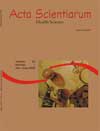<b>Quantification of soluble HLA class I antigens by ELISA assay</b>- DOI: 10.4025/actascihealthsci.v31i2.6758
Keywords:
soluble antigens, HLA, ELISA
Abstract
HLA (Human Leucocyte Antigens) molecules are regarded mainly as cell surface structures involved in several immune reactions associated with transplants, infections and auto-immune diseases. HLA antigens can be also found in soluble form in serum and in different fluids of the human body. The aim of this work was to develop the immunoenzymatic assay (ELISA) to quantify serum levels of specific and total soluble HLA class I antigens in normal individuals and in kidney patients. ELISA assay was developed to demonstrate the presence, in serum, of HLA-A2 (sHLA-A2), HLA-B7 (sHLA-B7) and total class I (sHLA-I) antigens. Eighty-eight serum samples were involved in this study, 61 from healthy individuals registered in the Regional Blood Center of the city of Maringá, Paraná State, and 27 kidney patients from dialysis centers of Maringá. The mean concentrations of sHLA-A2 and sHLA-B7, in healthy individuals, were respectively, 504.06 ng mL-1 ±142.10 and 427.33 ng mL-1 ±140.73. Preliminary results showed that sHLA-I in healthy individuals was 253.77 ng mL-1, and 381.67 ng mL-1 in kidney dialysis patients. The ELISA assay could be useful to detect soluble HLA antigens in comparative studies in different healthy populations, in several pathologies and in monitoring rejection in transplantation.Downloads
Download data is not yet available.
Published
2009-09-17
How to Cite
Boian, E. C., Andrade, R. M. de, Nakamura, L. Y., Medeiros, A. L., Boian, M. C., & Borelli, S. D. (2009). <b>Quantification of soluble HLA class I antigens by ELISA assay</b>- DOI: 10.4025/actascihealthsci.v31i2.6758. Acta Scientiarum. Health Sciences, 31(2), 95-99. https://doi.org/10.4025/actascihealthsci.v31i2.6758
Issue
Section
Clinical Analysis
DECLARATION OF ORIGINALITY AND COPYRIGHTS
I Declare that current article is original and has not been submitted for publication, in part or in whole, to any other national or international journal.
The copyrights belong exclusively to the authors. Published content is licensed under Creative Commons Attribution 4.0 (CC BY 4.0) guidelines, which allows sharing (copy and distribution of the material in any medium or format) and adaptation (remix, transform, and build upon the material) for any purpose, even commercially, under the terms of attribution.
Read this link for further information on how to use CC BY 4.0 properly.























5.png)







